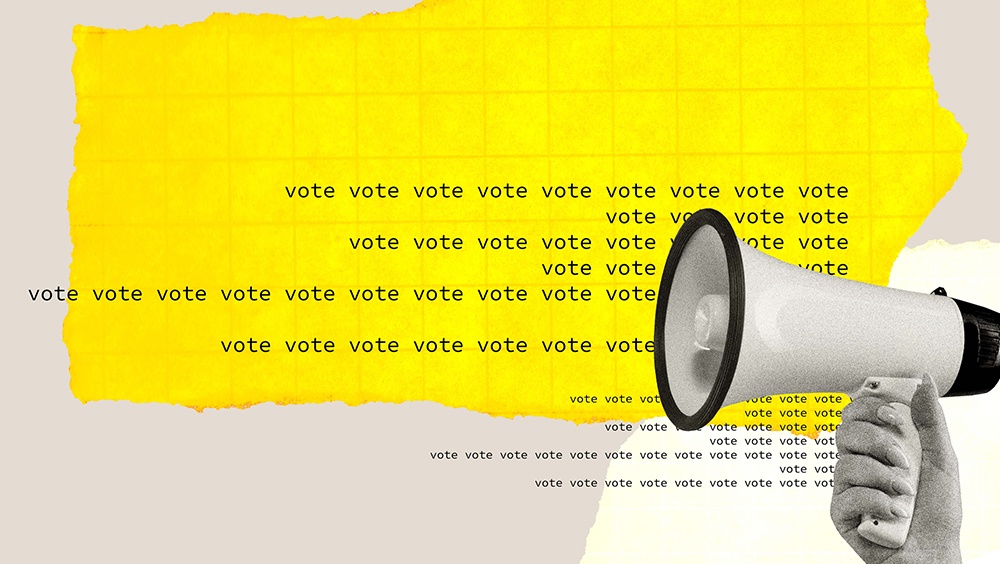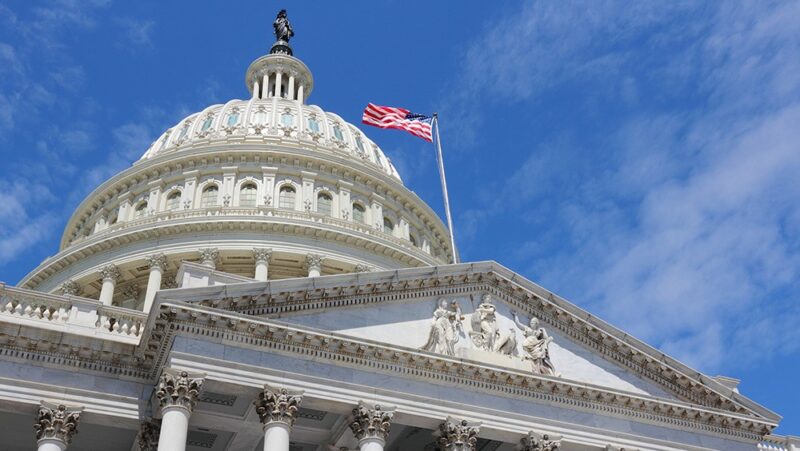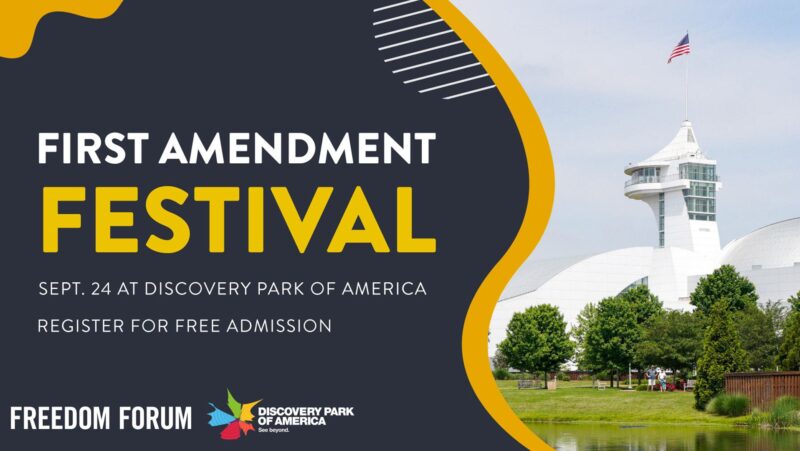Free Speech at the Polls: Know Your Election Day Rights

Election Day is just around the corner. This campaign season — like every campaign season — people have exercised their First Amendment freedoms of religion, speech, press, assembly and petition.
Those essential freedoms remain intact as you head to vote, but there are limits to how you can express yourself at your polling place.
Sometimes government officials have put limits on the right to free expression at or near polling places to ensure that people are free from intimidation or coercion when they go to vote.
The fundamental right to express yourself politically at or near polling places can only be restricted when the government can show that the speech or expression will interfere with someone else’s voting process or when it might endanger election integrity.
What are the limits on free speech near the polls?
Government officials can place limits on freedom of speech near polling places. The state can limit campaign signs and other similar forms of free speech within a certain distance of polling places. This means that government officials can enact, or create, a campaign-free zone right around or near the polls to protect voters from intimidation as they walk into their polling place. However, the campaign-free zone must be kept small to ensure that political speech can still occur where direct threat of intimidation is not as likely.
Which U.S. Supreme Court case established limits on speech near polling places?
In Burson v. Freeman (1992), the U.S. Supreme Court examined the constitutionality of a Tennessee law that prohibited “the display of campaign posters, signs or other campaign materials, distribution of campaign materials, and solicitation of votes for or against any person or political party or position” within 100 feet of the entrance to a polling place on election day. Violation of the law could lead to a misdemeanor conviction, a fine and up to 30 days imprisonment.
Tennessee contended the law was necessary to protect people’s ability to vote for the candidates of their choice free from intimidation. The state also argued the law furthered the compelling interest of protecting the right to vote in elections with integrity and reliability. However, candidate Rebecca Freeman argued that the Tennessee law was a content-based law limiting political speech in a public forum.
In his plurality opinion, Justice Harry Blackmun determined that the state’s interests in protecting voters from intimidation and fraud were so important that they justified limiting speech near the polls.
Blackmun emphasized that the Tennessee law was not a complete ban on speech, but a “minor geographic limitation” on speech. Blackmun concluded, “A long history, a substantial consensus, and simple common sense show that some restricted zone around polling places is necessary to protect that fundamental right.”
Justice John Paul Stevens, joined by Justices Sandra Day O’Connor and David Souter, dissented, pointing out that the Tennessee law limits “classic political expression.” He also emphasized the breadth of the law’s language, writing, “Bumper stickers on parked cars and lapel buttons on pedestrians are taboo. The notion that such sweeping restrictions on speech are necessary to maintain the freedom to vote and the integrity of the ballot box borders on the absurd.”
Court addresses different law restricting speech near polls
More than two decades later, the U.S. Supreme Court addressed another state law limiting speech in polling places in Minnesota Voters Alliance v. Mansky (2018). This law prohibited voters from wearing a “political badge, political button, or other political insignia” at the polls.
A voting group called the Minnesota Voters Alliance and several individuals contended this law violated their First Amendment free-speech rights. The Supreme Court noted that the law did not discriminate against speech based on viewpoint, as it applied to all types of political insignia. However, the court found the restriction was unreasonable.
Writing for the majority, Chief Justice John Roberts emphasized that the law failed to define “political” and thus could apply to buttons or T-shirts that simply encouraged people to vote. Roberts cited a 2010 Election Day Policy manual in the state that claimed the political apparel ban applies even to “issue-oriented material.” To Roberts, this restricted too much speech and speech that could not realistically cause any harm to voters.
So, can I wear a political T-shirt or badge near the polls?
You may be able to wear a political T-shirt or badge near the polls under the reasoning of the Supreme Court’s decision in Minnesota Voters Alliance v. Mansky. However, this decision only invalidated a Minnesota law that was written very broadly.
According to the National Conference of State Legislatures, 21 states still have laws on the books limiting the wearing of political apparel and buttons. Whether these laws survive the Supreme Court’s decision in Mansky is an open question.
The lesson here is that you need to check your state laws on this before proceeding to the polls.
Lower court upholds Wisconsin buffer zone law
Not all restrictions on speech near polling places reach the U.S. Supreme Court. Recently, the 10th U.S. Circuit Court of Appeals upheld a Wyoming law that prohibited electioneering within 300 feet of a polling place. John C. Frank contended the law violated his First Amendment rights because it prohibited him from handing out campaign materials and parking his car with a political bumper sticker within 300 feet of a polling place.
However, the 10th Circuit upheld the law in Frank v. Lee (2023). “Wyoming’s statute only prohibits electioneering within a one-minute walk from the entrance to the polling place; individuals may engage in electioneering anywhere else in the state on Election Day,” the appeals court reasoned.
Frank appealed to the U.S. Supreme Court, but the court declined to hear the appeal on April 15, 2024.
What about ballot selfies?
Another pressing issue involving free speech and voting concerns is ballot selfies, the ability of individuals to take and share photos of their ballots. Supporters of ballot selfies contend that they are a protected form of political expression. Others say that allowing ballot selfies is a threat to election integrity. For instance, they could lead to “vote buying”; the photo would serve as proof that you had followed through on an agreement to vote for a certain candidate. Election law scholar Richard Hasen contends that ballot secrecy should trump the right to take pictures.
State laws differ on ballot selfies. According to Ballotpedia, 25 states permit ballot selfies while another four allow them for absentee/mail-in ballots only. Sixteen states prohibit ballot selfies while five states and the District of Columbia are unclear on the issue.
The trend appears to be that more and more states recognize that individuals have a First Amendment interest in expressing their votes. However, once again, you will want to check your own individual state laws on ballot selfies before taking a photo of your ballot.
Still to be determined: Is there a First Amendment right to ballot selfies?
Having a law prohibiting ballot selfies doesn’t mean that law is constitutional. While the Supreme Court has never ruled on this specific issue, lower federal courts and some state courts have. The United States Court of Appeals for the 1st Circuit struck down New Hampshire’s ban on ballot selfies because it violates the First Amendment, while federal courts in Indiana, Colorado and California did the same. However, a federal court in New York upheld that state’s ban on ballot selfies as a legitimate way to prevent vote buying and coercion as did a state appellate court in Illinois.
Cases are pending in Ohio and North Carolina. The Ohio challenge was filed by Alison Kareem, who took a ballot selfie after voting in the November 2020 general election but did not post it because she feared prosecution under Ohio law. Instead, she filed a complaint against the Cuyahoga Board of Elections. Her lawsuit was dismissed by a federal district court that ruled that she lacked “standing” because she was in no immediate danger of prosecution. The U.S. Court of Appeals reversed that decision, saying there is a credible threat of enforcement against her. In March 2024, it sent the case back to the district court with instructions to consider Kareem’s First Amendment arguments.
In North Carolina, Susan Hogarth took a ballot selfie as she was voting in the March 5, 2024, primary. She posted it to the social media platform X with captions indicating her desire for a major third party and her opposition to the ballot selfie law. She received a letter from the state Board of Elections telling her that she had committed a Class 1 misdemeanor under North Carolina law and telling her to take down her social media post. Hogarth refused and instead filed a lawsuit seeking to have the ballot selfie law overturned because it violates the First Amendment. A federal judge in North Carolina denied Hogarth’s request for a preliminary injunction that would prevent the state from enforcing the law during the Nov. 5 general election. The judge ordered attorneys to draft an agreement that would ensure Hogarth is not prosecuted while the lawsuit is ongoing – something the district attorney had already said would not happen. The court will hear full argument on the law after the election.
David L. Hudson Jr. is a First Amendment fellow with Freedom Forum and an associate professor of law at Belmont University.
Five Freedoms, One Democracy
Union City, Tenn., celebrates the First Amendment at Discovery Park of America
Related Content
2025 Al Neuharth Free Spirit and Journalism Conference
All-Expenses-Paid Trip To Washington, D.C.
June 22-27, 2025
Skill-Building
Network Growing
Head Start On Your Future

